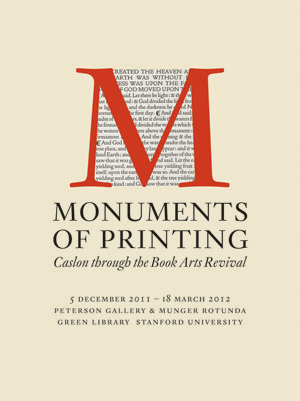 Monuments of Printing: From Caslon through the Book Arts Revival is the second of two exhibitions spanning five-hundred years of printing history. It explores typography and printing in Europe from the early 1700s through the 1930s as seen in works selected from the collections of the Stanford University Libraries by Curator of Rare Books John Mustain. Monuments of Printing, part two, will open Monday, December 5, in the Peterson Gallery and Munger Rotunda on the second floor of the Bing Wing of Green Library, Stanford University, and is free and open to the public.
Monuments of Printing: From Caslon through the Book Arts Revival is the second of two exhibitions spanning five-hundred years of printing history. It explores typography and printing in Europe from the early 1700s through the 1930s as seen in works selected from the collections of the Stanford University Libraries by Curator of Rare Books John Mustain. Monuments of Printing, part two, will open Monday, December 5, in the Peterson Gallery and Munger Rotunda on the second floor of the Bing Wing of Green Library, Stanford University, and is free and open to the public.
Typefaces by Caslon, Baskerville, Bodoni, and Gill, names familiar to computer users today, are seen in their original incarnations, along with engraved books, breakthroughs in color printing, and the fruits of the fine press movement of the late nineteenth and early twentieth centuries.
On display are some of the great typographic cornerstones of the eighteenth century: typographer and printer John Baskerville's first book, the works of Virgil (1757), the fine edition of Homer's Iliad printed by the brothers Foulis, printers to the University of Glasgow (1756), and Giambattista Bodoni's Manuale tipografico, published by his widow in 1818.
Engraver John Sturt's Book of Common Prayer (1717) boasts a diminutive, intricately engraved portrait of King George I overwritten with the entire text of the Lord's Prayer, The Prayers for the King and the Royal Family, the Apostles' Creed, The Ten Commandments, and Psalm XXI.
Oliver Byrne's The First Six Books of the Elements of Euclid (1847), "in which coloured diagrams and symbols are used instead of letters for the greater ease of learners," demonstrates four-color spot printing alongside The Grammar of Ornament (1868), a veritable cornucopia of chromolithography.
An embossed white-pigskin-bound copy of The Works of Geoffrey Chaucer, printed by Arts and Crafts Movement proponent William Morris at his Kelmscott Press (1896), The Four Gospels, printed on vellum by the Golden Cockerel Press with striking black-and-white illustrated initials by Eric Gill (1931), and Walt Whitman's Leaves of Grass, printed by the Grabhorn Press in San Francisco in 1930 are among the highlights of the volumes representing the Book Arts Revival of the early twentieth century.
Monuments of Printing: From Caslon through the Book Arts Revival will be on display from December 5, 2011 through March 18, 2012.
Exhibit cases are illuminated Monday through Saturday from 10 a.m. to 6 p.m. and Sunday from 1 to 6 p.m. The gallery is accessible whenever Green Library is open and hours vary with the academic schedule. For Library hours, visit http://library.stanford.edu/hours.